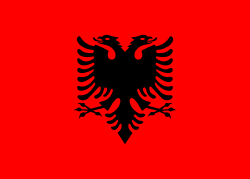Nacionalismo albanés
O nacionalismo albanés é un conxunto de ideas e conceptos nacionalistas xurdidos no pobo albanés a comezos do século XIX, durante o Espertar Nacional Albanés (en albanés: Rilindja). O termo tamén se asocia con conceptos semellantes, como o albanesismo[1][2][3][4][5] e o panalbanismo[6][7] e ideas que levarían á formación da Grande Albania.

Algunhas destas ideas adoptáronse parcialmente durante a República Popular de Albania, proclamada en 1946, que se centraba na continuidade entre os ilirios e os albaneses.[8][8] Porén, os valores fundamentais do Espertar Nacional Albanés seguen aínda vixentes ata o presente, e a ideoloxía desenvolvida durante o réxime de Enver Hoxha aínda está presente (aínda que "semella que hai vontade de cambio") na sociedade e institucións albanesas modernas, en Albania e en Kosovo.[9][8]
Os albaneses considéranse descendentes dos ilirios, aínda que non haxa ningún apoio científio a esta teoría. A idea do século XVIII segundo a cal os albaneses eran descendentes dos pelasgos[10] e que os etruscos[11] tiñan orixes ilirias aínda están presentes en certos círculos albaneses.[12] Estas ideas formaron parte da creación dun mito que permitiu a creación de movementos independentistas.[13][14][15][16]
Notas
editar- ↑ The Crescent and the Eagle: Ottoman Rule, Islam and the Albanians, 1874-1913 (Library of Ottoman Studies) by George Gawrych, 2006, page 20: "... dynamic that would remain essential for understanding the development of Albanianism."
- ↑ Kosovo: War and Revenge by Mr. Tim Judah and Tim Judah, 2002, page 12, the religion of Albanians is Albanianism
- ↑ The Oxford Companion to Politics of the World by Joel Krieger, 2001, page 475: "... frequently then and since, "The religion of the Albanians is Albanianism.
- ↑ One World Divisible: A Global History Since 1945 (The Global Century Series) by David Reynolds, 2001, page 233: "... the country."
- ↑ Stephanie Schwandner-Sievers, Bernd Jürgen Fischer, Albanian Identities: Myth and History, Indiana University Press, 2002, ISBN 978-0-253-34189-1, page 92 & (100)-(102)-(132)
- ↑ The Balkans: A Post-Communist History by Bideleux/Jeffri, 2006, page 423, "... form a 'Greater Albania'.
- ↑ Pan-Albanianism: How Big a Threat to Balkan Stability (Central and Eastern European) by Miranda Vickers, 2004, ISBN 1-904423-68-X
- ↑ 8,0 8,1 8,2 The practice of Archaeology under dictatorship, Michael L. Galary & Charles Watkinson, Chapter 1, page 8-17,2
- ↑ The practice of Archaeology under dictatorship, Michael L. Galary & Charles Watkinson, Chapter 1, page 8-17,2.
- ↑ Anthropological Journal of European Cultures, 2009, Gilles de Rapper, "by identifying with Pelasgians, Albanians could claim that they were present in their Balkan homeland not only before the "barbarian" invaders of late Roman times (such as the Slavs), not only before the Romans themselves, but also, even more importantly, before the Greeks‟ (Malcolm 2002: 76-77)."
- ↑ Anthropological Journal of European Cultures, 2009, Gilles de Rapper
- ↑ Dictionary of Deities and Demons in the Bible by Karel van der Toorn, Bob Becking, and Pieter Willem Van Der Horst, 1999, page 537, "Pelasgians, the mythical predecessors of Greek civilisation".
- ↑ Communism and the Emergence of Democracy by Harald Wydra, 2007, ISBN 0-521-85169-6, page 230, "Albanians tended to go further back in time to the sixth and seventh centuries, claiming an Illyrian- Albanian continuity and superiority over Slavic people.
- ↑ Anthropological Journal of European Cultures, 2009, Gilles de Rapper, "by identifying with Pelasgians, Albanians could claim that they were present in their Balkan homeland not only before the "barbarian" invaders of late Roman times (such as the Slavs), not only before the Romans themselves, but also, even more importantly, before the Greeks‟ (Malcolm 2002: 76-77)."
- ↑ The Balkans - a post-communist history by Robert Bideleux & Ian Jeffries, Routledge, 2007, ISBN 0-415-22962-6, page 513
- ↑ Kosovo: what everyone needs to know by Tim Judah, ISBN 0-19-537673-0, 2008, page 31